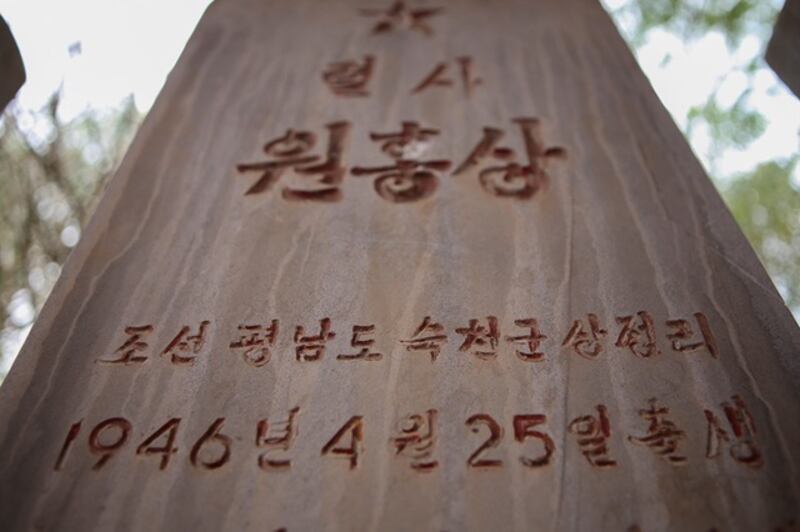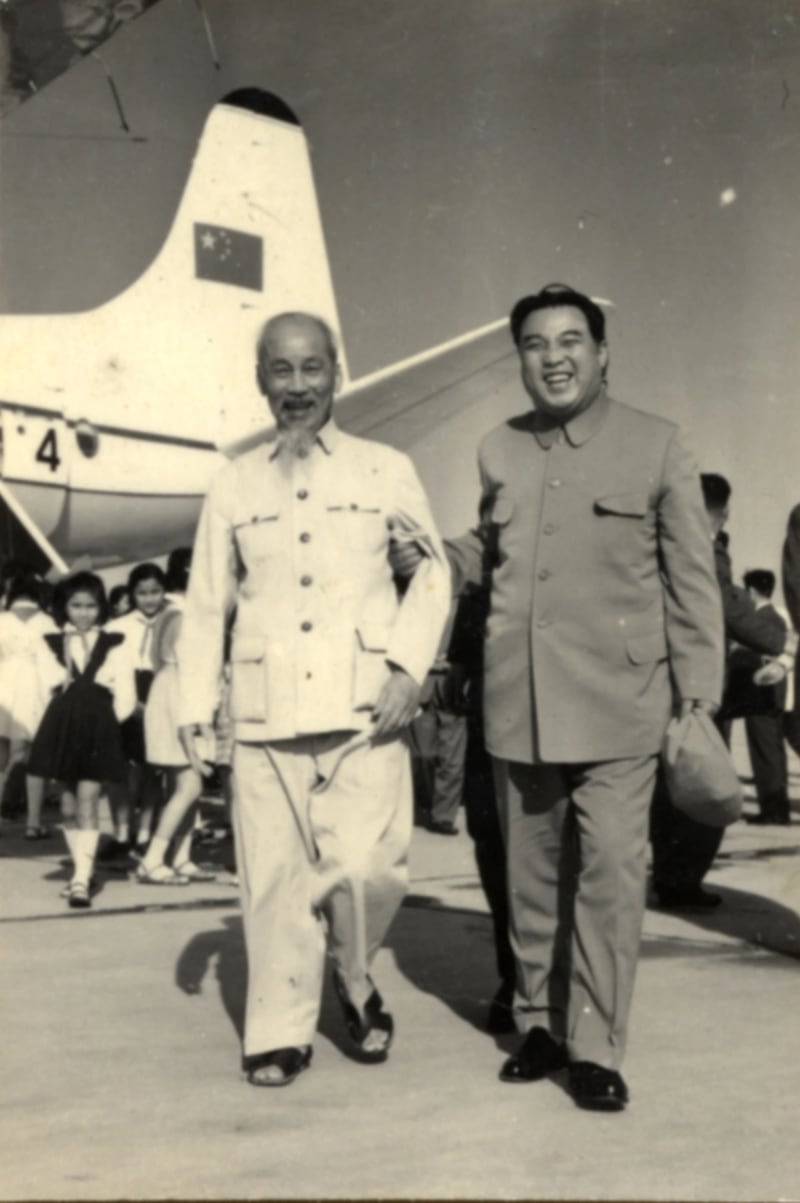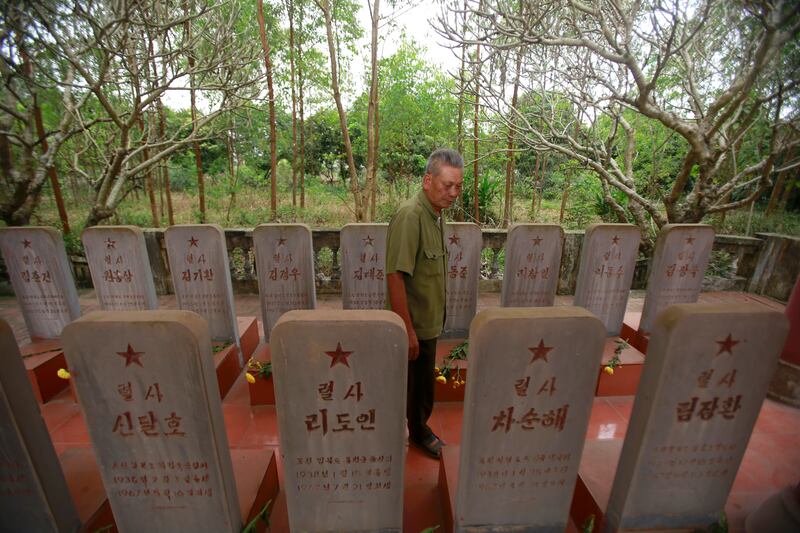In the 1960s, North Korea wanted its pilots to get combat experience in the battle against ‘imperialism.’
By Luna Pham for RFA
2024.10.30
A group of North Korean pilots pose with late Maj. Gen. Phan Khac Hy (first row, fourth from right), the political commissar of the North Vietnamese Air Force Command in an undated photo. (Maj. Gen. Phan Khac Hy’s family)
North Korea’s deployment of thousands of troops to help Russia fight its war against Ukraine has set alarm bells ringing in Western capitals. It has also prompted military analysts to look at Pyongyang’s past involvement in foreign wars for any indication of what to expect.
Over the past 60 years, the North Korean army is known to have directly taken part in the Vietnam War and the Yom Kippur War in the Middle East in 1973. The Vietnam War was the longer of the two and on a much bigger scale.
In 1965, Kim Il Sung, North Korea’s founder and grandfather of current leader Kim Jong Un, was sending young fighter pilots to North Vietnam to battle what they saw as Western imperialism and colonialism.

Headstone of Won Hong Sang, the first North Korean pilot killed in action in North Vietnam in 1965 aged 19. (Dan Tri newspaper)
The first, and the youngest, of the North Korean pilots to die in Vietnam was Won Hong Sang, shot down on Sept. 24, 1965, at the age of just 19. His death, however, didn’t deter the North Korean leadership from seeking a greater role in the war against the U.S. military.
Kim Il Sung’s request
The mission of North Koreans is seldom mentioned in Vietnam these days.
Vietnamese historians generally agree that it was Kim Il Sung who volunteered his young soldiers to fight for North Vietnam in the 1960s, contrary to the belief that Hanoi asked for the pilots because there was an acute need for them.
The founder of the Democratic People’s Republic of Korea, or DPRK, as North Korea is officially known, visited Vietnam in 1958 and 1964, the year the U.S. began open warfare in the country and its ally, South Korea, sent its first troops to South Vietnam.
An initial group of North Korean pilots was reportedly dispatched to Hanoi in 1965 for training on Soviet-donated fighter planes. More followed as the war escalated.
“Our friends had requested permission to send a volunteer air force unit to fight in Vietnam,” Phung The Tai, head of the Air Defense-Air Force Command, told a meeting of North Vietnam’s Permanent Central Military Party Commission on Sept. 21, 1966, referring to North Korea.
“Their personnel would be organized into companies to be integrated into our air force regiments, they would wear our uniforms, and they would operate from the same airfields as our air force.”
After getting approval from the presiding officer, Gen. Vo Nguyen Giap, North Vietnam and North Korea signed an agreement on the deployment of fighter pilots who “would be formally called ‘specialists’ but in reality they would be volunteer soldiers.”
From 1965 to 1969, North Korea sent about 100 personnel to serve in different roles in North Vietnam’s air force. South Korea’s Institute of Military History says the North sent “hundreds” of pilots but Vietnamese historians dispute that. Fourteen of the pilots were killed in combat.
“We had to agree to respect our allies but at the same time we had to maintain our own sovereignty” by clearly delineating areas of operations, as well as airfields, and responsibilities in order to “avoid unnecessary complications,” Giap instructed.
The North Vietnamese were uncomfortable with the idea of foreign troops fighting their war, especially as the North Koreans lacked technology and air combat experience.

Ho Chi Minh greeted North Korean leader Kim Il Sung who arrived at Gia Lam airport in Hanoi on Nov. 11, 1964 for his second official visit to Vietnam. (Ho Chi Minh Mausoleum)
A Vietnamese source with knowledge of relations with North Korea said Ho Chi Minh told Kim Il Sung in a 1964 meeting that Hanoi thanked him for his offer to help, adding that “just material assistance would suffice.”
“We only yielded after the DPRK insisted that their pilots really needed combat experience and familiarization with Soviet-made aircraft,” the source, who declined to be identified because of the sensitivity of the topic, told Radio Free Asia.
“But they got shot down a lot, and with them the planes,” he added. “Vietnam owed the DPRK much for its assistance during the Vietnam War such as food, ammunition and medicines, but the pilot program was not great.”
Extremely high fighting spirit
According to Merle Pribbenow, a former CIA officer turned independent researcher specializing in the Vietnam War, the deployment of North Korean fighter pilots in Vietnam was kept secret until 2000, long after the war ended.
The North Koreans served in an unidentified regimental-sized flying unit called “Group Z”, Pribbenow wrote, adding that it was based at Kep Air Base, northeast of Hanoi, from early 1967 through 1968.
Vietnamese media shed more light on “Group Z,” which suffered great losses between 1967-1968 and is believed to have been dissolved in 1969.
The group was sent to Vietnam because North Korea was “greatly impressed with the successes garnered by the Vietnamese air force,” the Vietnam People’s Police newspaper reported in July 2013.
“They were guided with utmost sincerity and diligence by the Vietnamese air force’s most experienced officers, and they learned all the most difficult techniques of how to operate MIG-17 and MIG-19 fighters,” the paper said.
The North Koreans were known for their “extremely high fighting spirit” and “some pilots even chained themselves to the seats, ready to die with the aircraft in the event of an accident,” it said.
In a 2023 memoir, Vietnam air force Lt. Gen. Pham Phu Thai, who was a fighter pilot during the war, described how North Korean pilots – who he called “friends Z” – “dived in without any hesitation, confronting the enemy planes ... the loud noise from the shooting and rocket explosions rocked the whole area.”
“Friends Z reported that they shot down five American airplanes, we accepted it was three but we couldn’t actually see any of those coming down,” Thai wrote of a confrontation on July 21, 1967, adding that three “friends Z” lost their lives in the battle.
From 1967-1968, “friends Z” conducted 1,266 sorties, and shot down 26 American aircraft, resulting in the capture of eight U.S. pilots, according to Thai.
‘Great sacrifice’
The 14 North Korean pilots killed in action in Vietnam were buried in the only cemetery for foreign war martyrs, in Bac Giang province near Hanoi, but they were repatriated in 2002 upon Pyongyang’s request.

In this Feb. 16, 2019, photo, war veteran Duong Van Dau walks in between a row of headstones at a memorial for North Korean fallen pilots in Bac Giang province, Vietnam. (Hau Dinh/AP)
North Korea’s official channels, for years afterwards, spoke of the great contribution and sacrifice that the North Korean people made to help Vietnamese brothers defeat “American imperialists and their lackeys.”
“The Vietnam War was depicted in North Korean state media as part of an overall Third World armed struggle against the forces of Western imperialism and colonialism,” said Benjamin Young, an expert on North Korea and research fellow at the RAND Corporation U.S. think tank.
“Due to its relative economic stability, the Kim Il Sung era was a heyday of North Korea’s socialist internationalism,” Young told RFA, adding that now the war in Ukraine is being framed by North Korean propagandists as an attempt to build a “new multipolar world.”
“North Korean state media then had articles mentioning volunteers signing up to go fight in Vietnam. It was a lot more public than the current situation where the North Koreans officially deny the presence of their soldiers in Russia,” he said. “I doubt the average North Korean is happy that their soldiers are being deployed thousands of miles away to go fight for another country.”
Inter-Korean relations also played a part in Pyongyang’s involvement in Vietnam.
Besides the pilot squad, North Korea sent special forces to areas in South Vietnam where South Korean troops were operating, “to study their fighting tactics, techniques combat readiness and the morale of the South Korean Army, and to use propaganda against the South Koreans,” the Romanian embassy in Pyongyang said in a secret telegram to Bucharest on July 6, 1967, obtained by the U.S.-based Wilson Center’s North Korea International Documentation Project.
This was “evidence that Kim Il Sung advocated for a greater North Korean military presence in Vietnam as a way to assess South Korea’s military capabilities,” said Young.
Young said inter-Korean rivalry was also likely to play out in the Ukraine War.
“South Korea will likely send lethal aid to Ukraine in a direct manner and make this public,” he said.
Some Western analysts believe that Kim Il Sung was happy to see America preoccupied with Vietnam to relieve its military pressure on North Korea.
His grandson, Kim Jong Un, born about a decade after the Vietnam War ended, might be equally happy to see the United States preoccupied with the war in Ukraine.
Edited by Mike Firn and Taejun Kang.

No comments:
Post a Comment